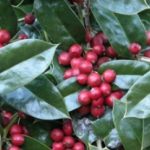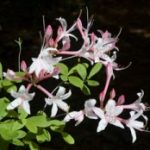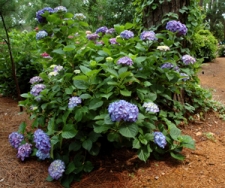 The hydrangea collection includes approximately 900 plants representing 20 different species and 200 different cultivars. The most prevalent species in the garden is the Bigleaf Hydrangea (Hydrangea macrophylla), but many other interesting types are found here too.
The hydrangea collection includes approximately 900 plants representing 20 different species and 200 different cultivars. The most prevalent species in the garden is the Bigleaf Hydrangea (Hydrangea macrophylla), but many other interesting types are found here too.
The hydrangea collection is designated an Official North American Collection by the North American Plant Collection Consortium (NAPCC). NAPCC is a program of the American Public Gardens Association in cooperation with the USDA Agricultural Research Service. As part of this national designation, the Garden is committed to holding and developing a collection of documented living plants according to specified standards. In addition, NAPCC-recognized plant collections are available for selection and breeding, taxonomic study evaluation, utilization, and other research purposes.
THE HYDRANGEA FLOWER
The Hydrangea “flower” is really a cluster of flowers called a corymb. It comes in one of three general forms: lacecap, mophead, or panicle. Each corymb usually has both sterile and fertile flowers. The flowers do not have petals, but the sterile flowers have developed very showy sepals (part of the outer portion of a flower known as the calyx).
Lacecaps have a flat plate-like corymb which has a row or two of sterile flowers with big sepals around the rim and a mass of tiny true flowers in the middle of the plate.
Mopheads have a solid head or dome made up of lots of sterile flowers and just a few fertile flowers hidden within. This form is also called a hortensia type. The heads last so long because the flowers are sterile and do not have to produce fruits or seeds. Most other flowers drop their petals once they’ve been pollinated and begin the task of producing seeds.
Panicles are cone-shaped corymbs that appear on some species such as Hydrangea paniculata and Hydrangea quercifolia.

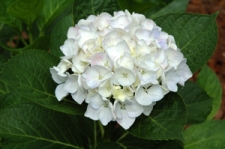
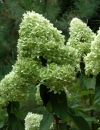
HYDRANGEA COLORS
Red or blue hydrangea flower color is determined by the amount of aluminum in the soil. The amount of aluminum available for the plant is determined by the acidity of the soil.
Red flowers are the result of alkaline or basic soil (a pH of 7-8), because the plant cannot absorb any aluminum in the soil. If there is no aluminum in the soil, as in a sterile potting mix, the flowers will be red regardless of pH.
Blue flowers occur when the soil is acidic (a pH of 6-7) and aluminum is available to the plant. Naturally acid conditions, such as under pine trees, can reduce the pH and change cultivars like “Pink Beauty” to rich shades of blue or purple. Clam shells, oyster shells or lime can be used to make the soil more alkaline to help maintain the red coloring.
Because the color of the hydrangea flower is also controlled by genetics, some cultivars may have dramatic changes, others not at all, and still others may only change slightly.
White flowers are not affected by soil acidity, although some cultivars may have a red or blue eye depending on the soil pH.
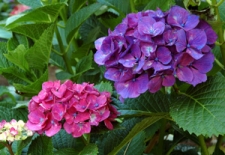


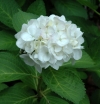
SPECIES HYDRANGEA
Most garden hydrangeas are cultivars of the Bigleaf Hydrangea (Hydrangea macrophylla). Our collection includes many other species of hydrangea.
 Hydrangea serrata
Hydrangea serrata
This comes from Japan and Korea and is a finer textured and refined version of Bigleaf Hydrangea with a lacecap inflorescence.
 Tree Hydrangea (Hydrangea paniculata)
Tree Hydrangea (Hydrangea paniculata)
This late blooming shrub grows up to 20 feet tall and is the most sun tolerant species. The blooms are panicles of creamy white sterile and fertile flowers, the proportion of which varies with each form and cultivar.
Climbing hydrangea (Hydrangea anomala subsp. anomola)
This is a slow growing deciduous climber that may reach 60 feet or more depending on the cultivar. It looks fantastic climbing up a tree as it clothes the entire trunk, surrounding it with white lacecap flowers in early summer. The roots do cling like ivy, which may cause a problem if the surface needs to be painted later.
 Hydrangea aspera
Hydrangea aspera
This unusual species has fuzzy stems and leaves and lacecap flowers that include generally blue fertile center flowers and white or pink showy sepals. The shrub can get as large as 8 feet or more.
NATIVE HYDRANGEAS
While most of the garden varieties of hydrangeas are from Asia, some species are native to North America. Our collection includes native hydrangea species, subspecies and cultivars of Hydrangea arborescens and Hydrangea quercifolia.
 Oakleaf hydrangea (Hydrangea quercifolia)
Oakleaf hydrangea (Hydrangea quercifolia)
This is native to the southeastern US from North Carolina to Florida to Louisiana. Triangular cones of creamy white flowers (panicles) bloom in the spring and the big bold leaves will turn rich crimson and purple in late fall.
 Smooth Hydrangea (Hydrangea aborescens)
Smooth Hydrangea (Hydrangea aborescens)
This is the most common hydrangea in eastern North American forests. It will flower on new growth as well as old growth. It will produce both lacecap and mophead flowers. It can produce large flowers & the cultivars “Annabelle” and “Grandiflora” are two of the most popular.


